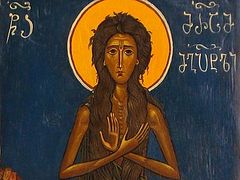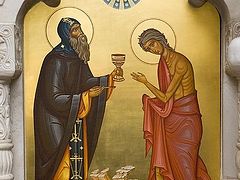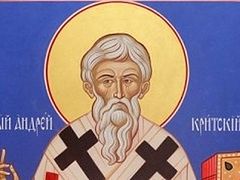Our Lenten journey has several important markers, several special liturgical days. One of these remarkable landmarks is the “standing of St. Mary”—the day [in the fifth week of Great Lent] when at the evening service the entire Canon of repentance of St. Andrew of Crete is read, and along with it, the faithful listen to the amazing life of a woman acetic who lived in the late fifth-early sixth century—St. Mary of Egypt.
I remember when I was fifteen years old, I went for the first time to the Standing of St. Mary Service, and heard the Life of the saint. It made an indelible impression on me. Even now I remember this service in minutest in detail: the unforgettable feeling of the triumph of life over sin, which this Saint’s Life impressed upon me. This feeling remains with me even now, two decades later; the life of St. Mary continues to amaze and inspire me.
I would like to note a number of remarkable moments in that life. First there is the figure of the ascetic monk Zosima, “of glorious life and gifted in speech, raised from childhood in monastic laborers and virtues.” The image of the Elder who had lived his entire life far from the vanity of the world and its temptations, from his earliest years practicing asceticism, made worthy of spiritual vision—is this not the ideal Christian ascetic? The confirmation of this can be heard in elder Zosimas’s question: “Is there a monk on earth who can be of use to me and show me a kind of asceticism that I have not accomplished? Could another wisdom loving desert dweller be found who has surpassed me in life or contemplation?” This question opens the amazing life of the ascetic woman, the history of a life so different from that of the Zosima, that you could even call it the direct opposite of the elder’s life, like black-and-white, if it weren’t for the second half of the story, which provides such an astounding contrast with the first half.
The story of Mary before her conversion to God is particularly realistic; it contains all the details of her life of fornication in her youth. One would think that the Author of this saint’s life would do well not to go into such detail about this, recalling various unseemly circumstances, so dissonant with the traditional example of a saint and angel in the flesh. But nevertheless, this fact of her life is underlined, and the author of the life through Zosima accents this part: “Speak, for the sake of God, my mother. Speak and do not break the thread of such an edifying story.”
The edification itself in the life begins with the episode in which Mary the harlot tells about her attempt to enter along with the faithful into the church for the services to the Exaltation of the Lord’s Cross: “When I stepped onto the threshold over which all the others were passing unhindered,” the saint relates to Zosima, “When I trod on the doorstep which everyone passed, I was stopped by some force which prevented my entering. Meanwhile I was brushed aside by the crowd and found myself standing alone in the porch. Thinking that this had happened because of my woman's weakness, I again began to work my way into the crowd, trying to elbow myself forward. But in vain I struggled. Again my feet trod on the doorstep over which others were entering the church without encountering any obstacle. I alone seemed to remain unaccepted by the church. It was as if there was a detachment of soldiers standing there to oppose my entrance. Once again I was excluded by the same mighty force and again I stood in the porch.”
From the Saint’s words we get a picture of the incompatibility of a sinner’s inner impurity with the true life going on outside of it; not with the life of “this world” but with the sacred Cross, thanks to which the world still stands. It is certainly no accident that Mary cannot get in to the church during the service to precisely the Cross of the Lord—this most important holy shrine of Christians and the first symbol of Christianity. From apostolic times, the Cross of Christ was understood to be the new tree of life—the symbol of God’s uniting with fallen man, the symbol of the path to the heavenly fatherland. A little later Christian apologists would treat the cross as a symbol of the whole of the world’s creation, or more precisely what strengthens it, upholds it, fills it with meaning, and prevents it from dissolving into chaos. Mary wants to see the life-Giving tree of the Cross but she cannot, for she had dedicated her entire existence to what opposes the cross—sin, mad passions, deeds of death.
And now the time has come for her to see. Horrified at the inexorable reality—her alienation from the sacred, from true life, Mary for the first time turns her mental gaze within: “The word of salvation touched the eyes of my heart, showing me that the impurity of my deeds barred my entrance.” Mary’s entire being is shaken with a deep, heartfelt repentance; in tears she turns to the mother of God, begging her to open the way for her to the church, that she might worship the life-creating cross. Mary makes a vow to the Heavenly Queen to abandon her sinful life, renounce the world, and go wherever she might lead her.
Thus, Mary finds the path to salvation first of all within herself, in repentance, in a self-denying yearning to follow God’s will. She embarks on the way of the Cross. And, finding herself on this path in her heart, she no longer meets that terrible external Barrier that separates her from the cross of life: “Having got as far as the doors which I could not reach before—as if the same force which had hindered me cleared the way for me—I now entered without difficulty and found myself within the holy place. And so it was I saw the Life-giving Cross. I saw too the Mysteries of God and how the Lord accepts repentance.”
Having turned into the path of salvation, Mary did not immediately become a saint. She had to pass through many trials, and overcome great temptations. The saint tells of her temptations in the Trans-Jordan desert, where she had been commanded from on high to go, far from the world, and again the details are just as realistic as they were in the narration of the sinful period of her life. The acetic tells how over the period of seventeen years since she departed into the desert, she lived “amidst thousands of dangers”: She was drawn to her former way of life, to entertainments and pleasures. Lustful thoughts and the fire of passion scorched her heart. She warred with her passions as with wild beasts. It is beyond human strength to withstand such mighty violence from the devil, but God, as the Life shows us, strengthened her in her struggle. The story of St. Mary’s temptations shows us the true cooperation between man and God in spiritual struggle. Here we also see the ascetic’s colossal effort of will to reject temptations and sinful passions; we see also the presence of God’s grace, illuminating the exhausted hermitess, and giving her blessed respite from temptation. Even more: we see here the link between human and divine will—the icon of the mother of God in the ascetic’s consciousness. Mary the desert dweller counters all the evil one’s calumnies with the Virgin Mary—the image towards which she strives with all her strength; her leader, to whom should promised to live a new life, and to fulfill the task that had been entrusted to her. The presence of the image of the Mother of God in St. Mary’s soul is also the presence of God in her life, strengthening and transforming her. It is also the ultimate expression of all her yearning—to correspond to the image of the true human being, the true Mary.
The figure of elder Zosima continues to be quite noticeable throughout the entire Life of St. Mary. As we said before, the life of St. Mary of Egypt begins with the question posed by this monk made wise through the reading of sacred books, ascecis, and years: “Is there any monk on earth who can show me and give me something new, Some Is there a monk on earth who can be of use to me and show me a kind of asceticism that I have not accomplished?” From the Life of St. Mary we receive not only an unambiguous answer that, yes, there are ascetics who are greater, but we also notice a certain sinfulness in Zosima’s question. First of all, we are given to know the relative nature of human measuring in the spiritual realm. No outward criteria can make a man righteous before God. The (formally) ideal monk Zosima pales in comparison with the former harlot, the unlearned desert dweller, the one who found within herself the boldness to call out to God from the abyss of her sin and to confirm herself in the word of God through the help of God himself. St. Mary ascends to sanctity entirely in God, without the support of a single step on the “ecclesiastical ladder” (traditions and cannons) in her spiritual ascent.
After the period of temptations and trials, Mary acquires blessed repose in God, but in this angelic state she presents herself as an earthly human: she forbids Zosima to tell anyone about her life until she has left this temporary life; she resist the elder’s reverence for her, wishes to receive the holy gifts from the hand of a priest, asks that he pray for her, and shows concern for the churches, the kings, and the people. Despite the fact that the Saint renounced the world, she does not separate herself from the earthly Church, or from sinful mankind. Even at the recollection of the miracles the saint performed, the reader does not get the impression of a saint completely estranged from the earthly life— she continues to be a person on earth, while at the same time, a dweller of Heaven.
Nevertheless, the mystery of her sanctity, her transformed, grace-filled state, came to be only between herself and the one to whom she dedicated her life. Through Christ is St. Mary given the whole world; she needs nothing in particular, possesses everything in her communion with God—“I eat and clothe myself with the word of God, the Master of all things.” Having acquired “the mind of Christ”, the acetic possesses perfect knowledge of everything—“I never studied from books. Neither have I heard anyone singing or reading from them. But the word of God, living and effective, itself teaches men knowledge.” Without a doubt, these words not only testify to the grace-filled, spirit-filled state to which she came after seventeen years of spiritual struggle in the desert. It is also an instruction to elder Zosima, who dared to consider himself perfect based on his scrupulous following of a traditionally correct life vocation, at which he had been placed from his early childhood. Mary, on the other hand, never sought the ideal way of life, but sought God Himself in Whom she attained perfection. The essence of this instruction helps us understand the remarkable theologian, ascetic, and monk—St. Maximos the Confessor. He distinguishes different kinds of knowledge of Christ—knowledge of Christ according to the flesh—this is the knowledge of God received indirectly through the letter, text, rites, history, or tradition. The knowledge of Christ according to the flesh isn’t perfect, because “fleshly” measuring is imperfect in and of itself. Here the word of God is present, but not directly—it is diffracted through the thickness of linguistic, cultural, and other human layers. The person who knows Christ only through the flesh is imperfect in his knowledge of the divine—though he may know all the church dogmas, cannons, and texts of Holy Scripture. You see, human language (no matter which one) cannot express the word of God flawlessly, to the full. In full measure and perfectly, the Word of God Itself is expressed from Himself, in the Spirit; and to be a possessor of the Spirit is the portion of him who strives towards the Living God through the multitude of reflections and images of the Divine Word in the in the “human” sphere; who strives to behold the word of God directly, to make his mind touch the divine Word, pulling away the veil that envelopes Him. According to St. Maximos’s thought, the apostle Paul witnesses precisely to this: Wherefore henceforth know we no man after the flesh: yea, though we have known Christ after the flesh, yet now henceforth know we him no more (2 Cor. 5:16). (Chapter on theology, 2:61). St. Mary called such knowledge of the Word of God the knowledge of Christ Resurrected. This knowledge can be obtained only through personal experience, as opposed to knowledge of Christ after the flesh, which is accessible to all.
St. Mary’s ascetic labor surpasses Zosima’s ascesis precisely by its all-conquering aspiration towards the Risen Christ. This is not even the ascetic labor comprised of some series of self-denying acts, but the state of the ultimate openness to God, to His action, which makes any ascetic labor, any action in the name of the Creator possible.
I am sincerely convinced that at the remarkable service of the Great Canon and “Standing of St. Mary” we can feel, comprehend, and understand the essence of Christian ascetic labor, co-standing with St. Mary in her fiery, bold striving toward the Savior, Who seeks out the soul of a sinner.





